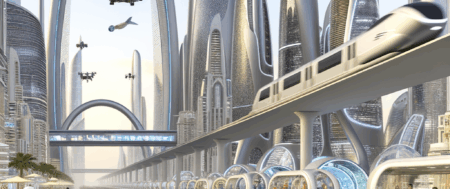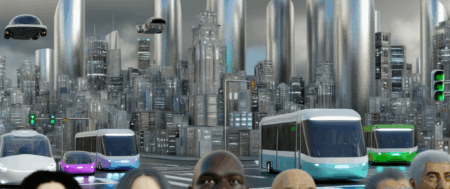This analysis dives into the latest transportation trends and mobility solutions, spotlighting the shift towards sustainable and efficient modes of travel amidst growing urban populations and environmental concerns. It covers the enhancement of public transportation, the rise of electric vehicles (EVs), and the effects of ride-sharing services and car-sharing programs on traditional transit. The piece also examines bike-sharing initiatives, autonomous vehicles, and smart city solutions as key drivers in creating sustainable transportation ecosystems. Despite the optimism, challenges such as the regulatory landscape, consumer behavior, and the environmental impact of new technologies are highlighted as pivotal in shaping the future of mobility. Through detailed market analysis and a review of technological innovations, the article provides a comprehensive outlook on how adapting to these changes is crucial for developing more connected and sustainable communities.
In an era where the way we move and connect is undergoing transformative changes, the latest Mobility Report emerges as an indispensable guide through the evolving landscapes of transportation and mobility solutions. This document not only delves into the current state and future prospects of the sector but also unpacks the intricate tapestry of transportation trends, from the burgeoning adoption of public transportation and ride-sharing services to the innovative strides in electric vehicles (EVs) and autonomous vehicles. As cities and societies strive to reconcile the demands of growth with the imperatives of sustainability, the report offers a panoramic view of the mobility ecosystem, covering car-sharing programs, bike-sharing initiatives, and the integration of smart city solutions.
The report is structured to provide a comprehensive analysis across various dimensions of the mobility sector. It begins by “Navigating the Future of Movement,” offering an in-depth analysis of transportation trends and mobility solutions that are shaping the global landscape. Subsequent sections such as “The Evolution of Transit” and “From Ownership to Access” explore the shifts in public transportation, ride-sharing services, and the rise of sharing economy models that prioritize access over ownership. “Charging Ahead” examines the impact of electric vehicles on global mobility, signaling a shift towards more sustainable transportation practices.
Further, the report ventures into the high-tech realms of “The Road to Autonomy” and “Tech-Driven Transit,” highlighting how autonomous vehicles and technological innovations are paving the way for smarter, more efficient transportation systems. The integration of smart city solutions and the emphasis on green moves underscore the industry’s commitment to sustainable transportation and environmental well-being. Through “Market Movements” and “Consumer Shifts,” readers are offered a lens into the market analysis and consumer behavior driving the adoption of mobility solutions.
As the mobility sector navigates through the complexities of the “Regulatory Landscape” and makes eco-driven decisions to mitigate the “Environmental Impact” of emerging trends, this Mobility Report stands as a crucial resource for policymakers, businesses, researchers, and stakeholders. It not only encapsulates the current dynamics and future directions of the transportation and mobility industry but also serves as a roadmap for pursuing sustainable, efficient, and inclusive mobility solutions across the globe.
1. “Navigating the Future of Movement: An In-Depth Analysis of Transportation Trends and Mobility Solutions”

In today’s rapidly evolving world, understanding the dynamics of transportation trends and mobility solutions has never been more crucial. As urban populations swell and environmental concerns take center stage, the mobility sector is undergoing a transformative shift. This in-depth analysis delves into the myriad facets of the industry, from public transportation enhancements to the rise of electric vehicles (EVs), offering a panoramic view of where we’re headed in our quest for more efficient, sustainable, and accessible forms of movement.
Public transportation, the backbone of urban mobility, is witnessing a renaissance. Cities worldwide are investing in smarter, cleaner, and more reliable systems to accommodate growing passenger numbers while reducing carbon footprints. This push towards sustainability is further amplified by the surge in electric vehicles (EVs), which are rapidly becoming a fixture on our roads. With advancements in battery technology and an expanding network of charging stations, EVs offer a promising path towards reducing the environmental impact of personal transport.
Ride-sharing services and car-sharing programs have also redefined what we consider public transit. By offering more flexible, on-demand options, they fill the gaps left by traditional transport methods, especially in underserved areas. This shift not only reflects changing consumer behavior but also highlights the importance of adaptability in mobility solutions. Similarly, bike-sharing initiatives are transforming urban landscapes, providing an eco-friendly alternative for short-distance travel. These programs not only alleviate traffic congestion but also promote healthier lifestyles among urban dwellers.
The frontier of transportation innovation is undoubtedly autonomous vehicles. These self-driving cars promise to revolutionize our roads by improving safety, reducing traffic jams, and offering new mobility options for those unable to drive. As they inch closer to becoming a mainstream reality, autonomous vehicles represent the pinnacle of technological innovations in the mobility sector.
Smart city solutions are integral to this evolving landscape, offering a holistic approach to urban planning and mobility. By leveraging data analytics and connectivity, cities can optimize traffic flows, improve public transportation systems, and enhance pedestrian and cyclist safety. This smart integration of technology and infrastructure is key to developing sustainable transportation ecosystems that can adapt to future challenges.
Yet, these advancements are not without their hurdles. The regulatory landscape is struggling to keep pace with technological innovations, creating a complex environment for mobility solutions to navigate. Consumer behavior, too, is a crucial factor, as adoption rates of new technologies and practices will ultimately determine their success or failure. Moreover, the environmental impact of these innovations remains a pivotal consideration. While many mobility solutions aim to reduce emissions and resource consumption, the full lifecycle effects of these technologies, including production and disposal, must be carefully managed.
In conclusion, the future of movement is being shaped by a confluence of factors, from market analysis and technological breakthroughs to regulatory shifts and environmental considerations. As we navigate through these changes, the mobility sector holds the promise of creating more connected, sustainable, and efficient communities. By understanding and embracing these transportation trends and mobility solutions, we can collectively steer towards a brighter, more mobile future.
In conclusion, the Mobility Report serves as a pivotal compass in navigating the rapidly evolving landscape of transportation trends and mobility solutions. It not only sheds light on the current state of public transportation, ride-sharing services, car-sharing programs, electric vehicles (EVs), bike-sharing initiatives, autonomous vehicles, smart city solutions, and sustainable transportation practices but also provides a forward-looking perspective on market analysis, consumer behavior, technological innovations, regulatory landscape, and environmental impact. As the mobility sector continues to transform under the influence of technological advancements and environmental considerations, this report is an invaluable tool for policymakers, businesses, researchers, and stakeholders aiming to stay ahead in the global quest for efficient, sustainable, and innovative transportation solutions. By offering comprehensive insights into the intricacies of the mobility industry, the report empowers decision-makers to craft strategies that not only respond to current demands but also anticipate future shifts in the transportation and mobility ecosystem.






